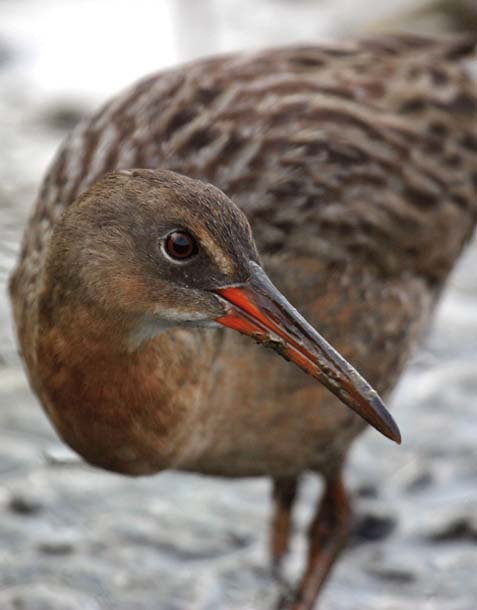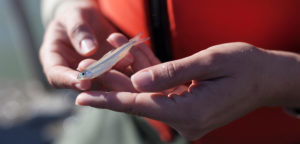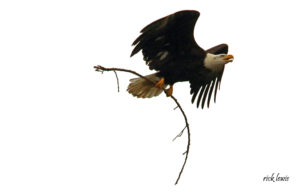To take in the view east from the top of Briones Peak, south of Martinez, is to drink in the iconic glory of California’s inner Coast Range: Velvet grasslands, colossal oaks, and shady ravines of bay laurel extend for hundreds of acres in every direction. It can seem as if little has changed since the Spaniards first arrived and claimed these hills for their ranchos.
But look more closely and you can’t help but notice the human hand in almost every part of this landscape. Roaming the fields are cattle that graze down European grasses and, it turns out, make room for native wildflowers. The ponds that dot the meadows were built for cattle but now are also maintained as habitat for rare tiger salamanders and red-legged frogs.
In the Bay Area, wilderness is almost always surrounded by intense human activity. That’s especially true in the East Bay, home to 2.5 million people–a third of the Bay Area’s human population–and more than 100,000 acres of land managed by the East Bay Regional Park District. The district is the East Bay’s largest owner of protected lands, and its staff works to give imperiled species a helping hand. Sometimes that simply means monitoring rare habitats, but it can also mean felling trees for the benefit of a native wildflower or even creating an artificial island for breeding birds.
“Doing nothing is not an option anymore in a lot of areas,” says biologist Stuart Weiss with the Creekside Center for Earth Observation, which has worked on key habitat projects for the district. “The age of fencing areas off and letting them take care of themselves–those are long gone if they ever existed. So finding ways to have very careful stewardship and management is going to be absolutely essential over the long run if we’re going to preserve biodiversity.”
An Island for Terns
The shoreline of San Francisco Bay has been among the habitats hardest hit by civilization. Over the past 150 years, more than 90 percent of the tidal marshes and beaches that once encircled the Bay have been lost to diking and development.
That’s been bad news for the California least tern, whose backswept wings make it look like an avian version of the Concorde jet, topped by a black cap with a white forehead stripe. This federally endangered species nests on open beaches and sandy spits, but these habitats are now vanishingly rare both around San Francisco Bay, where least terns probably nested only occasionally in the past, and in Southern California, where the largest least tern breeding colonies once existed.
To improve the least tern’s odds of survival, the district transformed an artificial island into a site tailored to the terns’ nesting needs. District Wildlife Resource Analyst David Riensche, affectionately known as Doc Quack, combined grant funding with vast amounts of volunteer time and labor to create almost three quarters of an acre of prime tern nursery off Hayward Regional Shoreline.
- A California least tern hunts for fish in the Bay. Photo by Jack Wolf.
“The island has been a monumental undertaking over the last nine years,” Riensche says. Since 2001, almost 3,000 volunteers have devoted about 11,000 hours to improving, monitoring, and protecting the tern island. “Volunteers are the backbone of what we do. None of this would have happened without people who wanted to make a difference.”
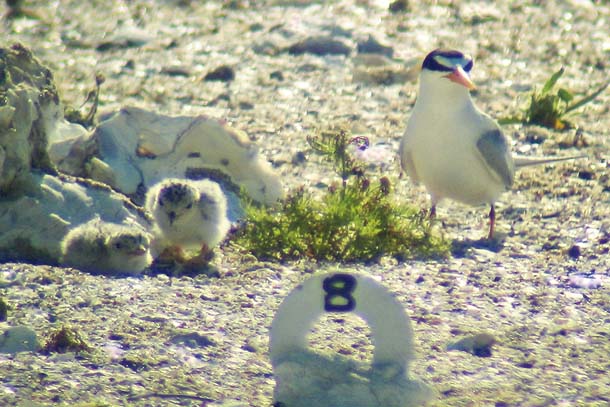
- Endangered California least terns nest on an artificial island at Hayward Regional Shoreline. Tern monitors watch the colony through birding scopes, using numbered markers to track nests. Photo by David Riensche, East Bay Regional Park District.
First, volunteers brought in 160 tons of sand and oyster shell, one 50-pound bag at a time. Over the ensuing years, staff and volunteers yanked and sprayed invasive weeds; replenished the supply of sand and shell on which terns like to nest; erected miniature shelters to protect chicks; and monitored the birds from a nearby levee.
Yet it wasn’t as simple as “build it and they will come.” To attract terns to the island, the district set up tern decoys and broadcast tern calls through speakers a few weeks before the spring breeding season. “They’re colonial nesting birds,” Riensche says. “If it looks like a tern, sounds like a tern, and parties like a tern, it must be a tern and in a good place to nest.” Observers spotted the first terns at the island in 2003, the first nests in 2005, and the first chicks in 2006.
The island colony has since achieved one of the state’s highest fledgling success rates. Between 2007 and 2009, the colony produced one surviving fledgling per pair of parents, compared to the state average of one surviving fledgling for every four pairs of parents. In 2009, the island attracted 80 pairs of nesters, making it perhaps the most densely packed least tern colony on the West Coast.
The rare habitat afforded by the island has even attracted a second federally protected species: the threatened western snowy plover. Riensche has recorded eight plover nests on the island over the years and is hoping for more this year.
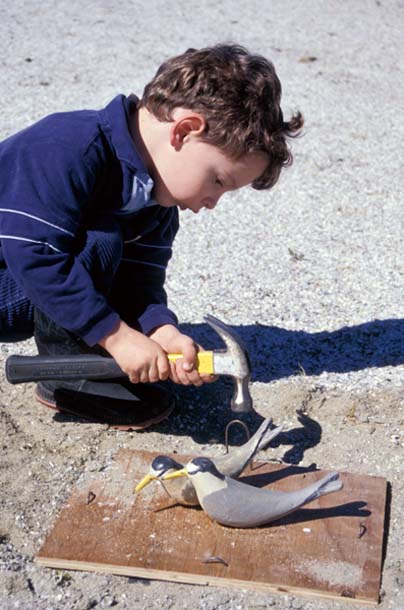
- A young volunteer places tern decoys in Hayward. Photo by David Riensche, East Bay Regional Park District.
Being on an island protects the birds from foxes and feral cats, but they are vulnerable to another recently arrived predator: the California gull. In 1980, fewer than 50 breeding California gulls were recorded in the Bay Area. By 2009, the resident population had exploded to an estimated 43,000 birds, thanks to a steady diet of trash from South Bay landfills. All too often, the gulls also eat California least tern and plover eggs and chicks. The gulls even wiped out the first generation of tern eggs and chicks back in 2005 and 2006.
The district discourages the gulls in every way it can, says Riensche. “We try to haze gulls out of the area with noisemakers and explosives. The idea is to discourage gulls from congregating in and around the Hayward basin.” In addition to raising a gull-unfriendly racket, Riensche has scattered “morbid decoys”–models of dead gulls–around the area. These strategies have kept chick mortality low so far, but the district will need to continue its gull control measures for the foreseeable future.
Clapper Rails and Cordgrass
Not all stewardship projects are as straightforward as the tern program. Efforts to improve habitat for the sake of broader biodiversity can sometimes clash with the needs of a particular species. That’s the case with an invasive plant now found alongside the Bay Area’s most endangered shorebird. The California clapper rail is a henlike bird of the tidal marshes that snaps up mussels and other morsels with a long, tweezerlike bill. California clapper rails once resided in wetlands from Humboldt Bay south to Monterey Bay; all of these populations have disappeared save for the roughly 1,000 birds in San Francisco Bay.
In the 1980s and 1990s, says district Ecological Services Coordinator Steven Bobzien, the district created tidal marshes at Hayward Regional Shoreline for the rails. At around the same time, the rail hit the ecological equivalent of a jackpot. A plant called Atlantic cordgrass (in the genus Spartina), a fast-growing species native to the East Coast, had been planted at several Bay marsh restoration sites, and it began hybridizing with native California cordgrass, creating hardy and even more invasive offspring. By 2006, the invaders had colonized over 2,000 acres within the estuary.
The rails, which rely on marsh vegetation to hide from predators, took to the thick new stands of cordgrass like newlyweds to a honeymoon suite. With the extra cover, their numbers skyrocketed. Martin Luther King Jr. Regional Shoreline’s Arrowhead Marsh harbored 63 rails in 1993, a number that increased slowly until 2000, when hybrid cordgrass began to flourish at the site. The birds responded accordingly, almost doubling to 112 by 2008.
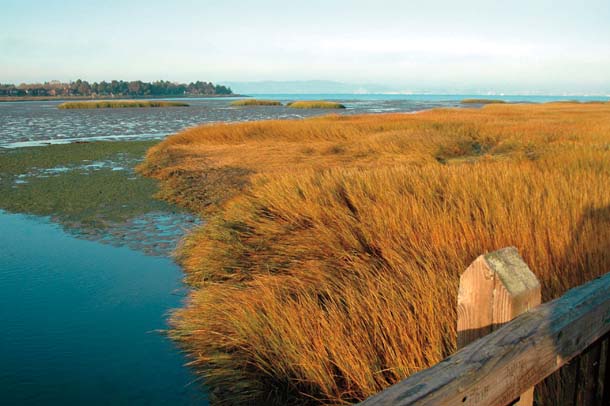
- This invasive hybrid cordgrass has been treated with herbicides. Hybrid Spartina presents an apparent contradiction for the management of endangered clapper rails: In the near term, it provides good cover, but it eventually grows too thick and chokes out the rails’ habitat. Photo by Drew Kerr, San Francisco Estuary Invasive Spartina Project.
Wildlife and land management agencies, however, were not so pleased by the spread of hybrid cordgrass. Alarmed by the plant’s ability to transform marshes into meadows and eliminate the mudflat feeding grounds of shorebirds, the state Coastal Conservancy launched the Invasive Spartina Project in 2000. Aerial spraying began making a dent in hybrid numbers after 2008, but the loss of cover vegetation has affected the rails. Bobzien’s high-tide surveys at the marsh show that the clapper rail population plummeted to 39 by 2010. The difference in cover was even reflected within the marsh: In 2008, biologists recorded 1.47 rails per hectare in a sprayed area, compared to 8.7 rails per hectare in a less intensively treated area.
But spraying is unlikely to stop until the hybrids are eradicated to maintain tidal habitat for other animals. Indeed, too much hybrid cordgrass eventually clogs marsh channels, starving out the rails as well. So the district is trying to improve rail fortunes in other ways, such as replacing nonnative Spartina with native vegetation, especially in upland areas where the rail retreats during high tides, says Bobzien. At Arrowhead Marsh, the district is cooperating with nonprofit group Save the Bay to plant marsh gum plant, saltgrass, and other species native to transitional marsh areas. The district also has programs to trap nonnative red foxes and feral cats and to block predator access.
Last of the Serpentine Prairie
.jpg)
- The serpentine prairie off Skyline Boulevard in Oakland has undergone substantial restoration. Photo by Wilde Legard, East Bay Regional Park District.
High in the Oakland hills, at the intersection of Skyline Boulevard and Crestmont Drive, lies a remnant of one of the state’s most botanically important habitats. In spring, the serpentine prairie in this corner of Redwood Regional Park erupts into spectacular native wildflower displays. Goldfields form a yellow carpet, while the rich buttery orange of California poppies stands out against the emerald grasses, themselves a mix of natives and invasive European species.
Serpentine grassland once covered hundreds of acres of the Oakland Hills, stretching west from the ridgeline down toward the flatlands. Today, the 46-acre parcel “might be the last extent of the original ecosystem” in Oakland, says Stuart Weiss.
Poor in nutrients and containing heavy metals, serpentine soils are inhospitable to most plants. However, many native bunchgrasses and wildflowers have evolved to make a living on these impoverished soils. Indeed, one tenth of California’s endemic plants are serpentine soil specialists.
Among the serpentine plant species found here is the federally endangered Presidio clarkia, which lives only here and in San Francisco’s Presidio. In late spring, it produces four-petaled flowers forming a delicate cup of fuchsia pink with a center saturated in deep red.
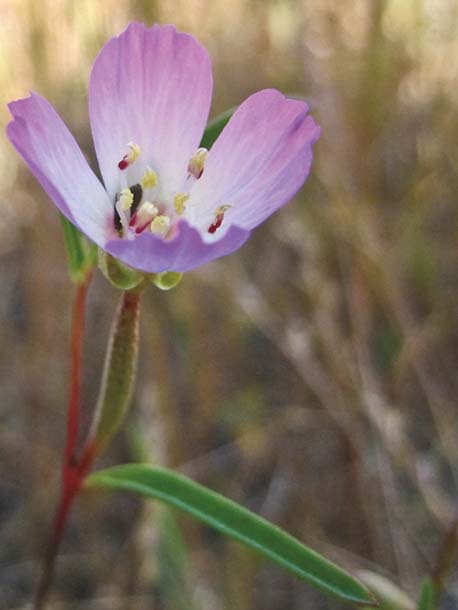
- The endangered Presidio clarkia survives only at the Presidio in San Francisco and on grassland in the Oakland Hills. Photo by Lech Naumovich.
The Presidio clarkia’s persistence here is a minor miracle. Starting in the 1950s, the land was used as a horse pasture and field course with obstacles and jumps. In the 1960s–before native habitats were valued by most land agencies–the district planted dozens of Monterey pines and acacias. More recently, the prairie became a favorite place for dog owners to let their pooches romp off leash.
So many humans, dogs, and horses came here that some parts of the meadow were compacted into bare earth. Fallen needles from the pines built up a thick layer of humus, and dog waste formed unnatural islands of nitrogen enrichment. The trees themselves captured fog and delivered extra water to the soil. Even car exhaust delivers nitrogen to otherwise nitrogen-poor serpentine prairies.
“I remember working out there in the ’70s and ’80s, but I hadn’t seen the serpentine prairie in a long time,” says the district’s Wildland Vegetation Program Manager David Amme. “One day I went out there, and I was totally blown away. It was only a shell of what it used to be.”
Concerned neighbors circulated a petition and turned to the California Native Plant Society (CNPS) for help. Amme worked with local residents, conservation volunteers from CNPS’s East Bay chapter, and officials from the California Department of Fish and Game to come up with a plan to protect the clarkia and other prairie plants.
District botanist Wilde Legard and a colleague conducted an inventory of the existing clarkia population–not a simple task. They worked for three weeks to create GPS-based maps and estimate the numbers of individual plants. Amme then asked Weiss, who had worked with the clarkia at the Presidio, to develop a management plan. Weiss identified a number of ways to tilt conditions in the clarkia’s favor, ranging from removing trees to fencing certain areas to exclude dogs, horses, and people.
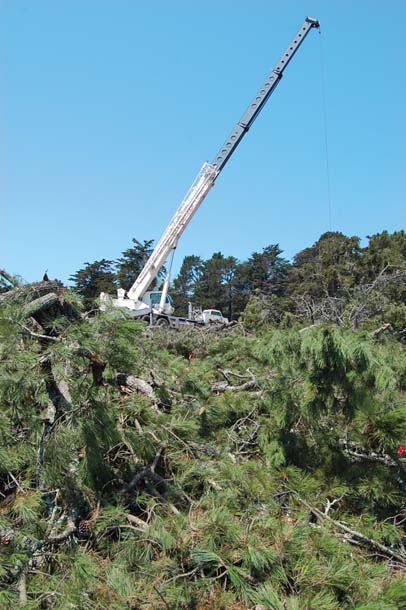
- The park district used a crane to remove trees, to avoid disturbing wildflower seeds in the soil. District biologists hope the small Presidio clarkia population here will eventually spread over a larger area. Photo by Wilde Legard, East Bay Regional Park District.
The district held a series of public meetings to explain the plan, hear concerns, and adjust accordingly. The final plan should help the entire community of native plants, endangered or not. “It was the first time the district had put together a resource management plan focused directly on a botanical resource,” says Laura Baker, East Bay CNPS conservation chair.
Starting in summer 2009, trees on the eastern edge of the site were cut and lifted away with cranes to avoid disturbing any clarkia seeds. The acacia and pine duff was removed and the ground sowed with native grass seed collected on the site. A broad swath of the prairie was fenced, and signs were posted to explain the restoration. More nonnative trees and duff will be removed in the future. “The hope is that the clarkia population will expand into the area on its own,” Legard says, “but we are willing to reseed if necessary.”
Using experimental plots, Weiss is studying how the clarkia fares inside fences versus outside, in shade versus full sun, and with or without mowing and raking. “You learn what’s working and what’s not as you go.”
Changes to the site have been accepted by dog walkers and plant enthusiasts alike. “We held our breath to see if there would be a public outcry, but there was none,” Baker says. “It went from being something the district was not dealing with to a showcase of what could be done when a resource is managed appropriately.”
Though intense management is often the order of the day, a few rare species require only minimal assistance, including the longhorn fairy shrimp of Vasco Caves and Brushy Peak regional preserves. These fingernail-size crustaceans live their entire lives within tiny puddles called tanks that collect after rainstorms atop local rock outcroppings, as well as in nearby vernal pools. Rain goads the shrimp to hatch, mate, lay egglike cysts, and die over the course of a few days. Its cysts–really embryos in suspended animation–can withstand heat, cold, and total dehydration for a decade or more before hatching out.

- At Vasco Caves Regional Preserve, small seasonal pools known as tanks are home to endangered fairy shrimp. The park district uses managed grazing by sheep to keep the tanks from becoming overgrown. Photo by Stephen Joseph, stephenjosephphoto.com.
Longhorn fairy shrimp are rare because their habitat is, and always has been, relatively scarce. To maintain the shrimp’s populations, the district prevents the pools from being polluted or vandalized by humans. Sheep grazing prevents vegetation from choking the pools, but shepherds have to be careful to keep their charges’ hooves and feces away from the tanks. The district also limits public access to Vasco. And to expand the shrimp’s available habitat, the district has created additional wetlands at nearby Souza Ranch, which is not open to the public at all.
As district staff work to protect these species and many more–from snakes and frogs to falcons and eagles–tensions between human residents and wildlife are inevitable in a region where so many vie for the same land, water, and resources. “So much natural resource management is about just that,” says Neal Fujita, the district’s stewardship manager, “trying to find that right balance.” The idea is that, decades from now, hikers at Briones Peak can still be surprised by a seemingly timeless landscape that owes as much to human care and dedication as it does to California’s native biodiversity.

.jpg)

